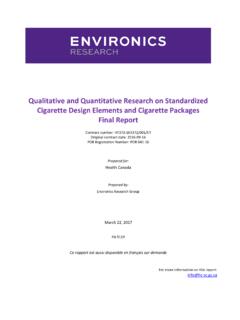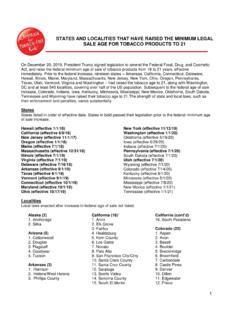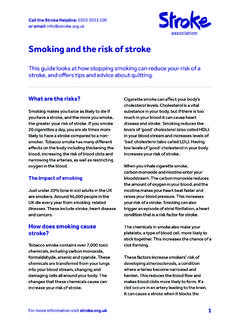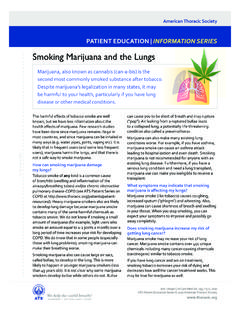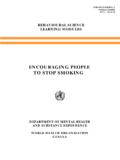Transcription of Smoking's Immediate Effects on the Body long 9-22-09
1 1400 I Street, NW - Suite 1200 Washington, DC 20005 Phone (202) 296-5469 Fax (202) 296-5427 Many teenagers and adults think that there are no Effects of smoking on their bodies until they reach middle smoking -caused lung cancer, other cancers, heart disease, and stroke typically do not occur until years after a person's first cigarette. However, there are many serious harms from smoking that occur much sooner. In fact, smoking has numerous Immediate health Effects on the brain and on the respiratory, cardiovascular, gastrointestinal, immune and metabolic systems.
2 While these Immediate Effects do not all produce noticeable symptoms, most begin to damage the body with the first cigarette sometimes irreversibly and rapidly produce serious medical conditions and health consequences. Rapid Addiction from Early smoking Many teenagers and younger children inaccurately believe that experimenting with smoking or even casual use will not lead to any serious dependency. In fact, the latest research shows that serious symptoms of addiction such as having strong urges to smoke, feeling anxious or irritable, or having unsuccessfully tried to not smoke can appear among youths within weeks or only days after occasional smoking first The average smoker tries their first cigarette at age 12 and may be a regular smoker by age Every day, more 3,500 kids try their first cigarette and about 1,000 other kids under 18 years of age become new regular.
3 Daily Almost 90 percent of youths that smoke regularly report seriously strong cravings, and more than 70 percent of adolescent smokers have already tried and failed to quit Immediate and Rapid Effects on the Brain Part of the addictive power of nicotine comes from its direct effect on the brain. In addition to the well-understood chemical dependency, cigarette smokers also show evidence of a higher rate of behavioral problems and suffer the following Immediate Effects : Increases Stress. Contrary to popular belief, smoking does not relieve stress.
4 Studies have shown that on average, smokers have higher levels of stress than The feelings of relaxation that smokers experience while they are smoking are actually a return to the normal unstressed state that non-smokers experience all of the Alters brain chemistry. When compared to non-smokers, smokers brain cells- specifically brain cell receptors- have been shown to have fewer dopamine receptors. Brain cell receptors are molecules that sit on the outside of the cell interacting with the molecules that fit into the receptor, much like a lock and key.
5 Receptors (locks) are important because they guard and mediate the functions of the cell. For instance when the right molecule (key) comes along it unlocks the receptor, setting off a chain of events to perform a specific cell function. Specific receptors mediate different cell activities. Smokers have fewer dopamine receptors, a specific cell receptor found in the brain that is believed to play a role in addiction. 8 Dopamine is normally released naturally while engaging in certain behaviors like eating, drinking and The release of dopamine is believed to give one a sense of reward.
6 One of the leading hypothesis regarding the mechanism of addiction theorizes that nicotine exposure initially increases dopamine transmission, but subsequently decreases dopamine receptor function and number. The initial increase in dopamine activity from nicotine results initially in pleasant feelings for the smoker, but the subsequent decrease in dopamine leaves the smoker craving more New animal studies have shown that brain chemistry and receptors may be altered early in the smoking Habitual smoking may continue to change brain chemistry, including decreasing dopamine receptors and thus yielding a more intense craving and risk of addiction.
7 These brain chemistry changes may be permanent. In addition, because the role played by receptors in other cognitive functions, such as memory and intelligence, is unknown, how cigarette smoking Effects smoking S Immediate Effects ON THE body Tobacco s Immediate Effects on the body / 2 other brain functions by altering brain chemistry is unknown. 12 Immediate and Rapid Effects on the Respiratory System The respiratory system includes the passages from the nose and sinuses down into the smallest airways of the lungs.
8 Because all of these spaces are in direct communication with one another, they can all be affected by tobacco smoke simultaneously. Bronchospasm. This term refers to airway irritability or the abnormal tightening of the airways of the lungs. Bronchospasm makes airways smaller and leads to wheezing similar to that experienced by someone with asthma during an asthma While smokers may not have asthma, they are susceptible to this type of reaction to tobacco An asthmatic that starts smoking can severely worsen his/her Bronchospasm makes breathing more difficult, as the body tries to get more air into irritated lungs.
9 Increases phlegm production. The lungs produce mucus to trap chemical and toxic substances. Small finger like hairs, called cilia, coat the lung's airways and move rhythmically to clear this mucus from the lungs. Combined with coughing, this is usually an effective method of clearing the lungs of harmful substances. Tobacco smoke paralyzes these hairs, allowing mucus to collect in the lungs of the Cigarette smoke also promotes goblet cell growth resulting in an increase in More mucus is made with each breath of irritating tobacco and the smoker cannot easily clear the increased mucus.
10 Persistent cough. Coughing is the body s natural response to clear irritants from the lungs. Without the help of cilia (above), a smoker is faced with the difficult task of clearing increased amounts of phlegm with cough alone. A persistent cough, while irritating, is the smoker s only defense against the harmful products of tobacco smoke. A smoker will likely have a persistent, annoying cough from the time they start smoking . A smoker who is not coughing is probably not doing an effective job of clearing his/her lungs of the harmful irritants found in tobacco Decreases physical performance.





